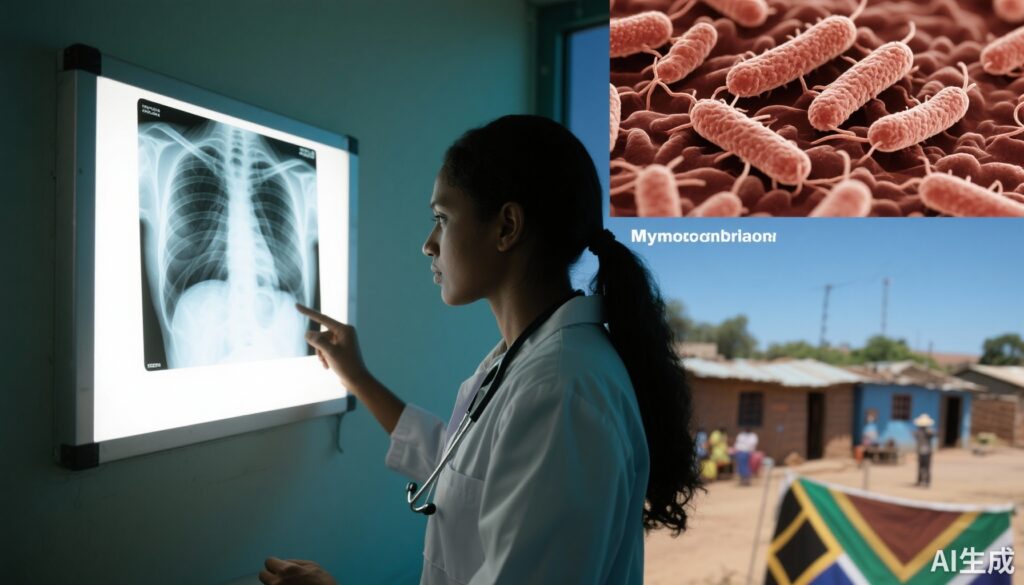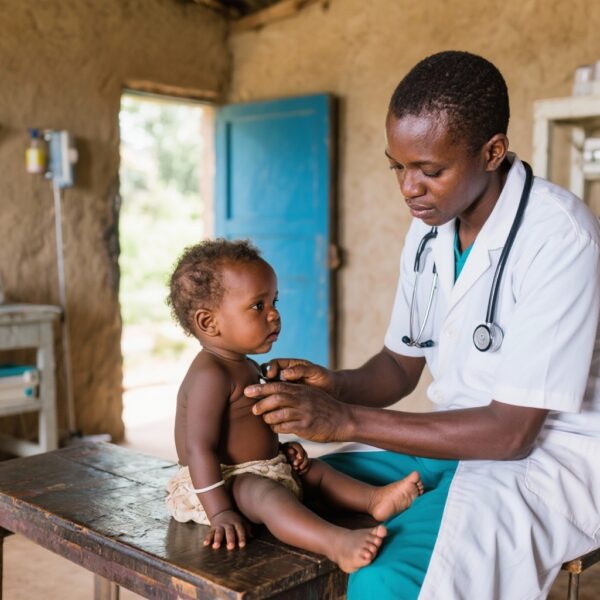Highlight
- Over 80% of microbiologically confirmed tuberculosis cases in household contacts were asymptomatic.
- Chest radiograph screening missed more than 40% of asymptomatic tuberculosis cases.
- Conventional symptom-based and radiological screening likely underestimate tuberculosis prevalence in endemic settings.
- C-reactive protein failed to differentiate asymptomatic tuberculosis from healthy contacts, limiting its utility as a screening biomarker.
Study Background
Tuberculosis (TB) remains a global public health challenge, especially in endemic regions such as South Africa, where household contacts of patients with pulmonary TB represent a high-risk group for infection and progression to active disease. Community prevalence surveys often find that more than half of TB cases are asymptomatic, raising questions about the adequacy of current screening strategies that rely heavily on symptom reporting and chest radiography. Detecting these asymptomatic cases is critical to interrupting transmission and achieving TB control targets. This study aimed to evaluate the diagnostic yield of combined symptom and chest radiograph screening alongside microbiological testing among adult household contacts of pulmonary TB patients in South Africa to better understand the burden of subclinical tuberculosis and the limitations of existing screening tools.
Study Design
This prospective observational cohort study enrolled 979 adult household contacts (≥18 years) of pulmonary TB index cases identified through local health services in three sites across South Africa (Worcester, Ravensmead in Western Cape Province, and Soweto in Gauteng Province). Eligible participants had household exposure within the preceding six months to individuals with untreated or partially treated TB. Exclusion criteria included inability or unlikelihood to attend study visits, psychiatric disease, substance dependence, or incarceration. Detailed screening was conducted, including:
- Symptom assessment for any duration of TB-compatible symptoms.
- Chest radiography evaluated for any abnormalities indicative of active TB.
- Microbiological testing of sputum samples with smear microscopy, Xpert MTB/RIF Ultra assay (Xpert Ultra), and liquid culture.
- Serum C-reactive protein (CRP) levels measured by multiplex bead array as a potential biomarker.
The primary endpoint was the diagnostic yield (sensitivity) of microbiologically confirmed pulmonary tuberculosis, stratified into symptomatic and asymptomatic disease based on the presence or absence of TB symptoms.
Key Findings
Of the 979 participants enrolled, 35.2% were male and 64.8% female; 18.9% were living with HIV and 19.1% had a history of prior TB. The prevalence of microbiologically confirmed TB was 5.2% (51/979). Strikingly, 82.4% (42/51) of those with TB were asymptomatic, underscoring the silent burden in this high-risk population.
Among asymptomatic TB cases, only 31% were sputum smear-positive, and of these, 61.5% had a low bacillary burden (scanty or 1+ grade smears). This low bacterial load complicates detection using conventional microscopy-based methods.
Chest radiograph abnormalities suggestive of TB were identified in 56.1% of asymptomatic TB cases (23/41) and 88.9% of symptomatic cases (8/9). Combined symptom and chest radiograph screening achieved a sensitivity of 64.0% (32/50) for all prevalent TB, indicating substantial underdiagnosis when relying on these conventional screening approaches alone.
CRP levels failed to distinguish asymptomatic TB from healthy contacts effectively, with an area under the receiver operating characteristic curve of 0.60 (95% CI 0.47–0.73), limiting its value as a screening biomarker.
These findings highlight that chest radiography missed over 40% of asymptomatic TB cases, revealing a critical gap in the current screening paradigm.
Expert Commentary
This study illuminates a significant challenge in TB control: a large reservoir of asymptomatic individuals with microbiologically confirmed disease who may contribute to transmission yet remain undetected by typical screening algorithms. The limited sensitivity of symptom and radiographic screening, especially among asymptomatic individuals with low bacillary loads, emphasizes the need for enhanced diagnostic strategies.
Current reliance on patient-reported symptoms may insufficiently capture subclinical TB, and chest radiographs, while more sensitive, still lack adequate sensitivity when used alone or in combination with symptoms. Additionally, CRP, an inexpensive and widely available inflammatory biomarker, does not reliably identify asymptomatic TB, indicating a need for novel biomarkers or diagnostic tools.
The study’s strengths include prospective design, well-characterized high-risk cohorts, and comprehensive microbiological confirmation. Limitations include the exclusion of certain populations (psychiatric illness, incarceration), which may affect generalizability. Also, the study sites in South Africa may not be fully representative of other high TB burden settings with differing epidemiology or healthcare infrastructure.
Conclusion
This prospective cohort study from South Africa reveals a predominance of asymptomatic TB among household contacts, with conventional symptom and chest radiograph screening strategies missing a substantial proportion of infections. Findings suggest that current community prevalence surveys depending on these approaches may significantly underestimate true TB prevalence, particularly subclinical disease.
To advance TB elimination efforts, enhanced screening strategies incorporating more sensitive diagnostics—potentially including molecular tests, improved imaging modalities, or novel biomarkers—are urgently needed to effectively identify and treat asymptomatic active TB. Public health programs should consider expanding active case finding beyond symptomatic screening to better capture the silent reservoir driving ongoing transmission in endemic regions.
Funding and Clinical Trials
This work was supported by the Regional Prospective Observational Research for Tuberculosis South Africa (RePORT SA), with funding from the US National Institutes of Health, the Civilian Research and Development Foundation, and the South African Medical Research Council. The study is documented under clinical trial registration number not specified in the original text.
References
– Mendelsohn SC, Mulenga H, Tameris M, et al. Screening for asymptomatic tuberculosis among adults with household exposure to pulmonary tuberculosis: a prospective observational cohort study. Lancet Glob Health. 2025 Nov;13(11):e1869-e1879. doi:10.1016/S2214-109X(25)00276-1.
– World Health Organization. Global Tuberculosis Report 2023. Geneva, 2023.
– Pai M, Behr MA, Dowdy D, et al. Tuberculosis. Nat Rev Dis Primers. 2016 Sep 22;2:16076.
– Jain A, Dixit P. Challenges in diagnosis and treatment of latent tuberculosis infection. Ann Thorac Med. 2017 Jul-Sep;12(3):141-146.


